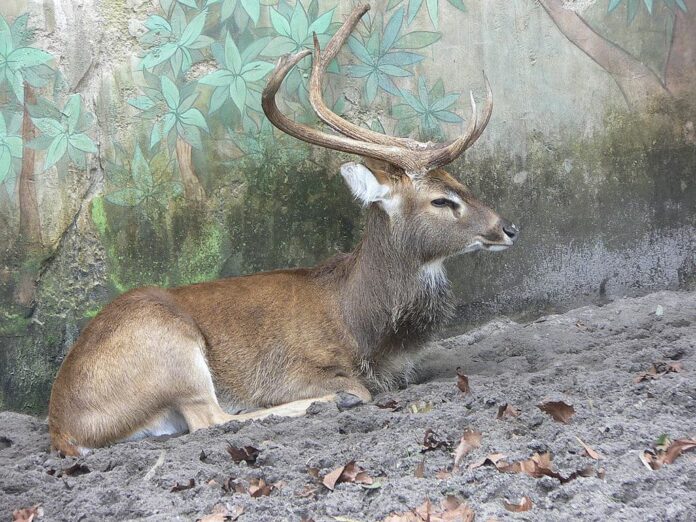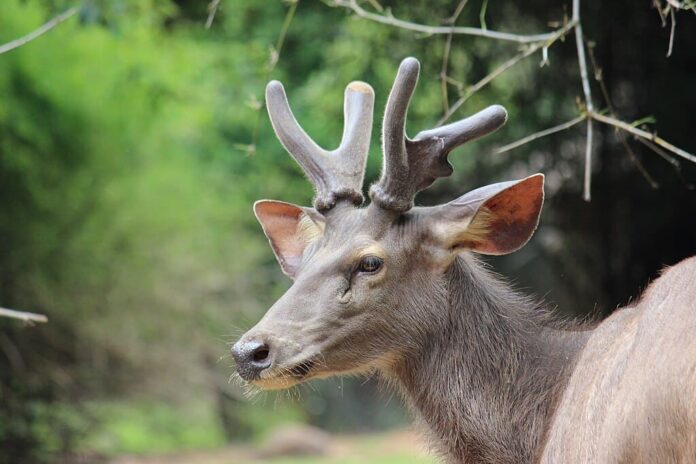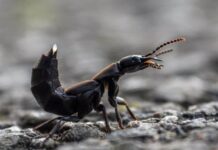Sangai is a very close relative of Eld’s deer, both of which are endangered at the moment. Due to the unique appearance and behavior, it also goes by other nicknames such as brow-antlered deer and dancing deer. Sangai has a deep connection and root with people for a very long time, and we are going to learn more about them below.
1Appearance

Sangai is a medium-sized deer that reaches an average height of around 1.1 to 1.2 meters at the shoulder. A sangai has a graceful appearance of long legs and a thin neck with a white patch on the throat. The body of the deer is covered with coarse hairs, and the lips, mouth, and nose of a sangai are dark brownish-black. It has a dark reddish brown winter coat that turns paler in summer, and it has a short tail. Males are darker and taller than females.
This deer has uniquely distinctive antlers that other deer species don’t have. The antlers are 100 to 110 centimeters long with multiple tines, and they are usually unsymmetrical to each other. These long antlers have a forward curve with the brow tines spreading like a crown. Its antlers have an extremely long brow tine that forms the main beam. The two tines form a continuous curve at right angles to the closely set pedicels. As for the forward protruding beam, it appears to come out from the eyebrow, hence the nickname brow-antlered deer. However, females have much shorter and less branched antlers, while some may lack them entirely.
2Behavior

A sangai walks on the hind surface of its pasterns as its hooves sink in the spongy and moist ground. With graceful leaps over floating foliage, it looks like the deer is dancing; hence the nickname dancing deer. They are social animals that hang out in small herds of 2 to 20 individuals. These dancing deer become aggressive during the mating season, which is between February and May. Males will compete with each other by rutting, andthe winner gets to control a harem of females they can mate with. The gestation period is around 8 months, and the female gives birth to a single fawn. It stays with its mother until it reaches adulthood, which is around 2 years old.
3Feeding & Habitats
As herbivores, these deer feed on a wide variety of grasses, herbaceous plants, sedges, shoots, and water-living plants. Thanks to their ability to swim, feeding on aquatic plants such as lilies and lotus is not difficult for them. It starts feeding as early as 4AM in the morning, and it spends its daytime resting under thick and tall grasses and reeds.
Sangai is a deer species endemic only in Manipur, India, and it is also the state animal of Manipur. The natural habitat of the sangai is the floating marshy grasslands of the Keibul Lamjao National Park called phumdi. Phumdi contains a floating marsh of vegetation formed by the accumulation of organic debris and biomass with soil. These floating meadows provide both food and shelter for the deer, along with protection from predators.
4Legends
Manipuris have both folklore and legends with sangai, believing that sangai is the binding soul between humans and nature. Killing a sangai is an unforgivable sin, and this is why this deer is the state’s animal. Not to mention it is one of the rarest animal species in the world, the sangai is a prized possession of Manipur. The state also celebrates the Manipur Sangai Festival annually since 2010, from the 21st to the 30th of November. Every year, a large crowd of various Manipuri groups and tribes attends the festival to celebrate their accomplishments. The locals can compete and take part in a variety of activities, cultural events, and sports during the 10 days. Craftsmen and weavers showcase their products and skills where people can purchase bamboo handicrafts and shawls. There are also drinks and food with regional ingredients and spices that everyone can try.
5Threats
The main threat that the sangai is facing is habitat degradation due to the artificial reservoir. The water quality of the reservoir is degrading due to pollution and the stoppage of nutrient supply. Along with that, they are also facing other threats such as diseases from livestock, floods, inbreeding depression, and poaching. There are fewer than 200 sangai left in the wild currently, while the threats keep increasing. Unfortunately, there is no conservation program to protect this state animal’s habitat and safety yet.
Related Post: World’s Largest Deer Species




